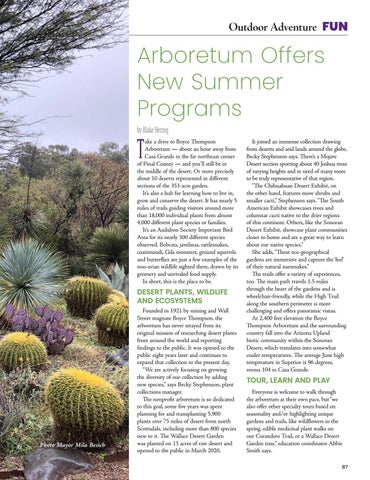Outdoor Adventure FUN
Arboretum Offers New Summer Programs by Blake Herzog
T
ake a drive to Boyce Thompson Arboretum — about an hour away from Casa Grande in the far northeast corner of Pinal County — and you’ll still be in the middle of the desert. Or more precisely about 10 deserts represented in different sections of the 353-acre garden. It’s also a hub for learning how to live in, grow and conserve the desert. It has nearly 5 miles of trails guiding visitors around more than 18,000 individual plants from almost 4,000 different plant species or families. It’s an Audubon Society Important Bird Area for its nearly 300 different species observed. Bobcats, javelinas, rattlesnakes, coatimundi, Gila monsters, ground squirrels and butterflies are just a few examples of the non-avian wildlife sighted there, drawn by its greenery and unrivaled food supply. In short, this is the place to be.
DESERT PLANTS, WILDLIFE AND ECOSYSTEMS
Photo Mayor Mila Besich
Founded in 1921 by mining and Wall Street magnate Boyce Thompson, the arboretum has never strayed from its original mission of researching desert plants from around the world and reporting findings to the public. It was opened to the public eight years later and continues to expand that collection to the present day. “We are actively focusing on growing the diversity of our collection by adding new species,” says Becky Stephenson, plant collections manager. The nonprofit arboretum is so dedicated to this goal, some five years was spent planning for and transplanting 5,900 plants over 75 miles of desert from north Scottsdale, including more than 800 species new to it. The Wallace Desert Garden was planted on 13 acres of raw desert and opened to the public in March 2020.
It joined an immense collection drawing from deserts and arid lands around the globe, Becky Stephenson says. There’s a Mojave Desert section sporting about 40 Joshua trees of varying heights and in need of many more to be truly representative of that region. “The Chihuahuan Desert Exhibit, on the other hand, features more shrubs and smaller cacti,” Stephenson says. “The South American Exhibit showcases trees and columnar cacti native to the drier regions of this continent. Others, like the Sonoran Desert Exhibit, showcase plant communities closer to home and are a great way to learn about our native species.” She adds, “These eco-geographical gardens are immersive and capture the ‘feel’ of their natural namesakes.” The trails offer a variety of experiences, too. The main path travels 1.5 miles through the heart of the gardens and is wheelchair-friendly, while the High Trail along the southern perimeter is more challenging and offers panoramic vistas. At 2,400 feet elevation the Boyce Thompson Arboretum and the surrounding country fall into the Arizona Upland biotic community within the Sonoran Desert, which translates into somewhat cooler temperatures. The average June high temperature in Superior is 96 degrees, versus 104 in Casa Grande.
TOUR, LEARN AND PLAY Everyone is welcome to walk through the arboretum at their own pace, but “we also offer other specialty tours based on seasonality and/or highlighting unique gardens and trails, like wildflowers in the spring, edible medicinal plant walks on our Curandero Trail, or a Wallace Desert Garden tour,” education coordinator Abbie Smith says. 87



